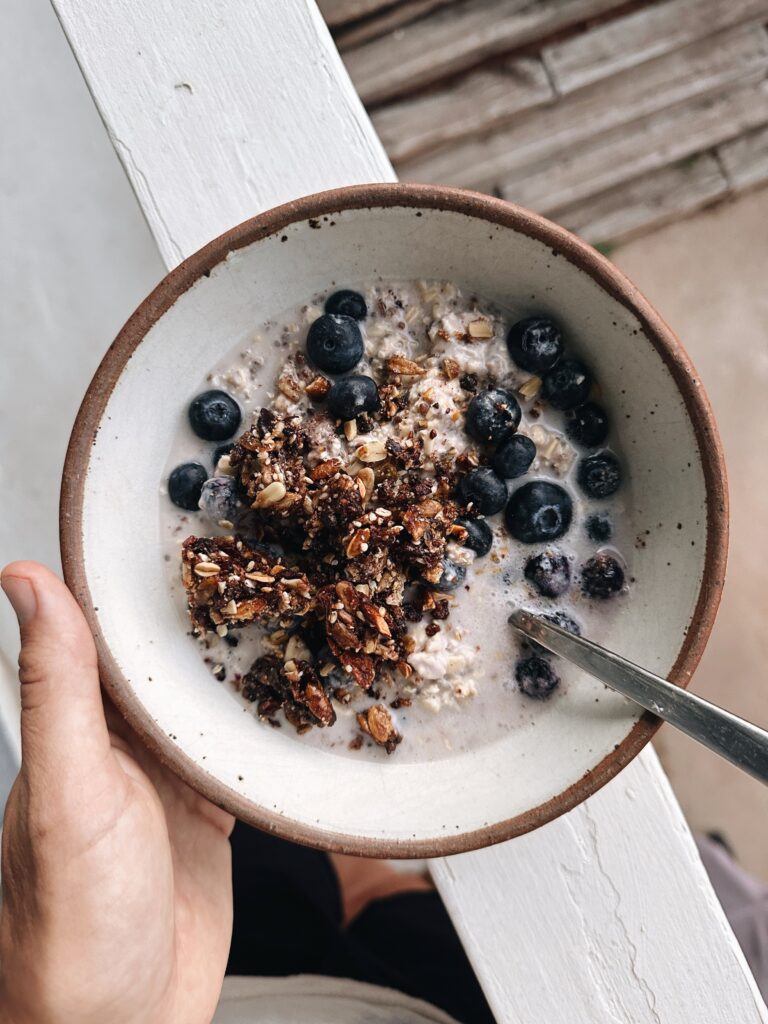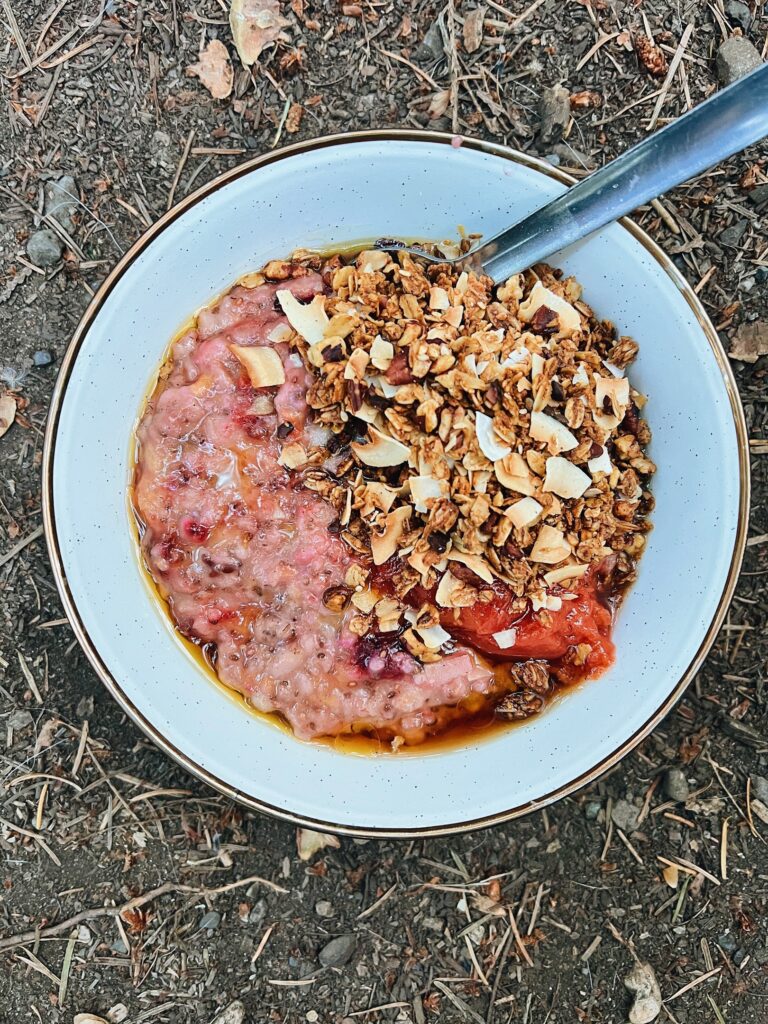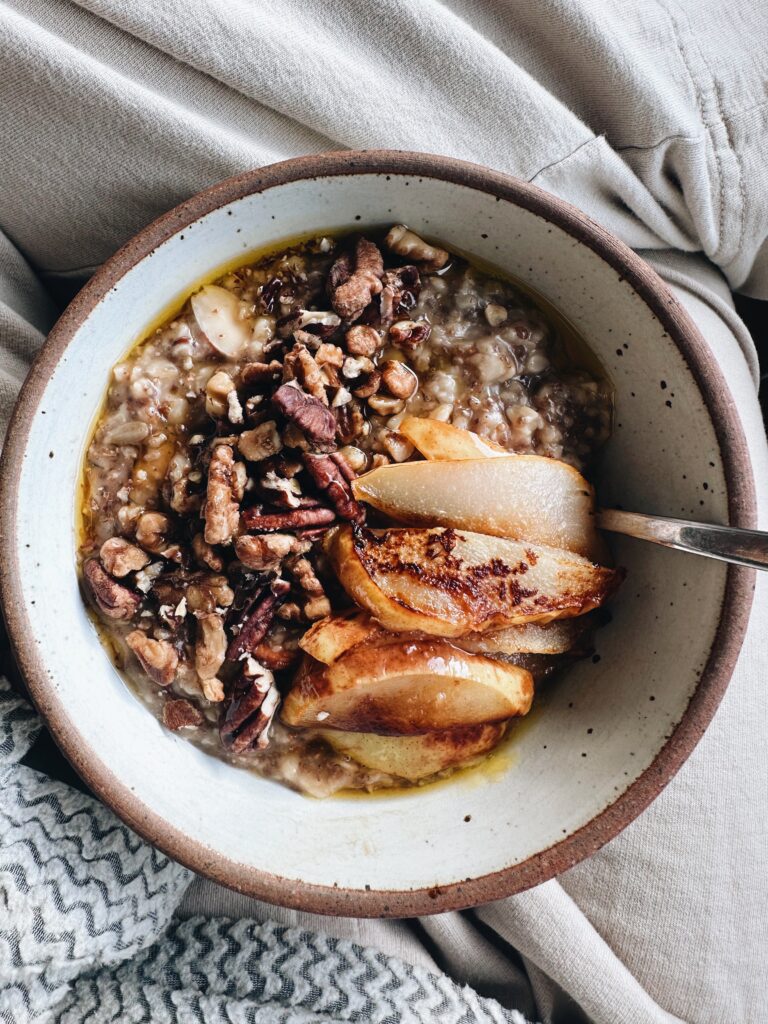

It may sound crazy, but oatmeal is one of the greatest canvases for deliciousness that I can think of. There are so so many ways to make it delicious, so many ways to make it easy AND, when we dial in our personal oatmeal recipes to suit our doshas, we balance our bodies and beings right there in our breakfast bowl.
“WHAT is she talking about?” you may be asking.
Well, when I close my eyes and imagine a steaming hot bowl of oatmeal, I imagine warm, steamy spiced oats, a drizzle of maple, a sprinkle of crunchy granola, stewed fruits, and maybe even a dollop of yogurt or a splash of cream if I’m feeling fancy. Sounds decadent and nourishing, right? This bowl may sound delicious for all…but this recipe might not be as nourishing as it sounds DEPENDING on your dosha.
According to Ayurveda, every substance (dravya) is either healing, neutral, or poisonous, depending on its gunas, or qualities.
A substance is medicinal when its qualities bring your system closer to balance, and it becomes toxic if it affects your digestion (agni) negatively or imbalances your doshas.
Suffice to say that having a warm breakfast is pretty smart. Making it *mostly* the night before is really a pro-move. But fine-tuning your oatmeal recipe to suit your specific constitution is downright brilliant. If we want to give our bodies an even bigger head start, balancing our breakfast bowls is the best way to start the day.

From an Ayurvedic standpoint, oats are sweet in flavor and, regardless of the form they’re enjoyed in (cookies! oatmeal! as a tea!) are considered to have soft, heavy, sticky, warm, and slightly oily qualities. These qualities and the dominant sweet taste make oats a natural balancer for vata (rough, mobile, cold, light) and pitta (oily, sharp, hot, light, liquid.) These qualities and the dominant sweet taste are particularly balancing for vata dosha, and the sweet taste, along with the heavy and soft qualities, are balancing for pitta. But, the qualities of oats and the qualities of kapha are quite similar; kapha is moist, smooth, oily, cool, and heavy. This means that oats are aggravating to kapha, and kapha conditions unless they’re prepared correctly. (Another job for the gunas!)
Ayurveda doesn’t shy away from sweeteners. But, like everything in Ayurveda, the sweetener to use depends on the dosha and the qualities of the circumstances (ie: what you’re sweetening!) Some favorite sweeteners and their doshic effects:

This is where things start to get pretty interesting when you’re building a bowl of Ayurvedic oatmeal. This is because Ayurveda is about to make you question all of the “ordinary” things you might add. Sorry! But also not sorry because, friends, what you’re about to build is a truly delicious, nutritious bowl that really serves you.
Here’s how to best serve up your oats:
Ghee
Ghee (clarified butter) can be an excellent tridoshic choice for topping your oatmeal. Feel free to use ghee generally in any of the below oatmeal recipes!
Yogurt
Yogurt *can* be okay for all three doshas, but as with everything else, it needs to be used in specific ways. All doshas will benefit from fresh yogurt, and all doshas will benefit from avoiding commercial or frozen yogurt. Coconut yogurt is okay too. If you’re going to enjoy yogurt on your oatmeal, however, Ayurveda reminds us that dairy yogurt and fruit are not compatible for optimal digestion. Choose either yogurt or fruit, but not both. (Note: the exception here are dates, or the combination of coconut yogurt and fruit. Dairy yogurt and raw or stewed fruit are not advisable for digestive health.)
Nuts & Seeds
Nuts and seeds are lovely additions to your oatmeal, and they provide a satisfying crunch. But, the nuts and seeds you choose should be dictated by your dosha.

This is a process that needs almost no introduction; put all of your ingredients into a big glass jar or big bowl. Place in the refrigerator overnight. You oats will be ready to eat in the morning! BUT, this is where my recommendation for overnight oats differs. It’s really important that you still eat your oatmeal warm. That’s right. Because cold oats – which are already sticky, heavy and oily – may create sludge in the digestive system. BUT, when we warm our oats, we really get to benefit from the grounding, warming elements of this nutrition. The overnighting process hydrates the oats, which means warming is all we need to do to have our breakfast ready. I recommend doing this quickly on the stovetop or in a microwave if you must, but warmed overnight oats is what we’re looking for.
Great question! First, I’d start with taking the dosha quiz.
This quiz is a great place to start better understanding your doshic constitution (your prakruti – or innate state of being, in Ayurvedic medicine.) That said, our bodies and beings are CONSTANTLY under the influence of other doshas in our lives. Because the doshas are in the foods we eat, the experiences we have, the weather in nature, and doshic qualities even apply to times of day, times of the month, our thoughts and our emotions, depending on how we’re living our lives, and what we’re eating we are likely to be out of balance with our innate state of being. This is what we call our vikruti in Ayurveda, or our present state of being. The goal of Ayurvedic medicine is to pull our present state of being as close to our innate state of being as possible – we want our vikruti to closely match our prakruti whenever possible. This is the reason to adjust our foods, our routines, our practices, and our performance efforts to suit our doshas. Working with an Ayurvedic practitioner can help with this – we can fine tune so much more than your oatmeal!
Once you know your dosha, choose the recipe that matches that dosha. The recipe will help you to finely tune your breakfast to your being!
Flavors are FUN, yes, but they also are the mechanisms by which our bodies nourish themselves. Flavors basically tell our bodies what the food is giving us – on a nutritional and energetic level. Our bodies then prepare enzymes to break those components down, assimilate them, and turn them into fuel for our vibrant lives. We can’t eat just one flavor and get all of the things we need, so learning to track the flavors in our foods helps us to be sure that we’re really getting all of the things we need in our meals. This particular recipe has four of six flavors. The more flavors we can enjoy in any meal or food, the happier and more balanced our bodies will be. If you’re wanting to learn more about how the flavors we eat fuel our bodies – energetically and nutritively, check out this little blog post.
A truly BALANCED breakfast is personal.
In a quart-sized glass jar or large bowl, combine all of the ingredients for the overnight oats that suit your dosha and stir to incorporate. Seal or cover the jar or bowl, then place in the fridge overnight.
In the morning, transfer your now porridge-like overnight oats to a small-saucepan. Add filtered water to your desired thickness – just to help easily warm the oats. Warm until the oatmeal is steamy but not piping hot. Remove from the stove and divide between bowls.
For vata:
For pitta:
For kapha: